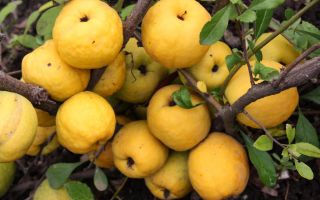Content
- 1 Chemical composition and calorie content of Japanese quince
- 2 Why is Japanese quince useful?
- 3 Can Japanese quince be pregnant and lactating
- 4 Is Japanese quince good for children?
- 5 What diseases does Japanese quince help with?
- 6 Traditional medicine recipes
- 7 The use of Japanese quince in cosmetology
- 8 What can be cooked from Japanese quince
- 9 Harm of Japanese quince and contraindications
- 10 How to choose and store Japanese quince
- 11 Conclusion
What are the benefits and harms of Japanese quince, and why is it not too common? Some may not have even heard of this vibrant, golden yellow pear-shaped fruit. As you can see in the photo, the Japanese quince or chaenomeles shrub is very attractive, and the beneficial properties of the product are unique. In fact, this is a healthy gift from nature that you should definitely add to your list of regularly consumed foods.
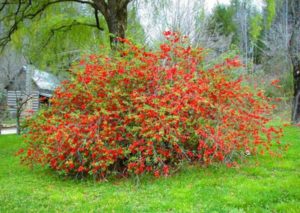
Japanese quince is a small and round pome fruit that is grown on shrubs. The benefits of decorative Japanese quince are often not properly appreciated. Despite the fact that in appearance it can look deliciously sweet and juicy, its properties are completely different. In its raw state, it is very hard, astringent and sometimes sour. To enjoy all the health benefits this product offers, it's best to cook it. Japanese quince is an ideal ingredient for making desserts, especially in autumn.
Chemical composition and calorie content of Japanese quince
Japanese quince is a highly nutritious food that is also very low in calories. One fruit weighing one hundred grams has 57 kcal. It is an excellent source of dietary fiber, minerals, vitamins and antioxidants. Chaenomeles contains tannins, including epicatechin and catechin, and is distinguished by a high concentration of ascorbic acid. Plus, Japanese quince is an excellent source of copper, calcium, potassium, iron, and magnesium.
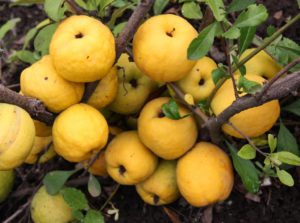
Why is Japanese quince useful?
Japanese quince is a low-calorie product. As noted, 100 grams of fresh raw pulp contains only 57 calories. In addition, chaenomeles contains several vital polyphenolic antioxidants, moreover, in higher quantities than apples and pears. Each fruit is a storehouse of phytonutrients such as dietary fiber, minerals and vitamins.
Quince pulp, together with the skin, has a significant amount of fiber. In addition, its granular granules are composed of astringent compounds known as tannins, namely epicatechin and catechin. They react with carcinogenic toxins and chemicals in the colon, and thus protect the mucous membrane from cancer, inflammatory bowel disease and diverticulitis. It also helps to reduce weight and blood levels of "bad" cholesterol (LDL).
Japanese quince contains several phenolic compounds such as caffeoylquinic acid, procyanidin-B2, oligomeric procyanidin, polymeric procyanidin, etc., as well as many essential oils (furfural, limonene, linalool, vomifoliol, toluene, beta-ionone, a-terpineol etc.). All these compounds give the fruit its unique flavor.
Ripe quince fruit has a good concentration of vitamin C.One hundred grams of this fruit provides 15 mg, or 25% of the daily value of this compound. Fruits rich in this vitamin help remove harmful free radicals from the body. Vitamin C helps to boost immunity, reduce viral infections and inflammation.
Japanese quince is an excellent source of minerals such as copper (130 mcg or 14% of the DV), iron, potassium and magnesium, and B vitamins, especially thiamine, riboflavin, and pyridoxine (vitamin B6).

Quince fruits, like pears, have anti-allergenic and anti-inflammatory properties. Its seeds can be beneficial in the treatment of cystitis and atopic dermatitis.
For women
The benefits of Japanese quince fruits for the female body are as follows. Consuming it is one of the likely ways to reduce weight and ensure a fast metabolism. It does this by improving digestion. Japanese quince has a lot of fiber, like many hard fruits. This means that the gastrointestinal system functions more regularly and efficiently: this way a person gets enough energy and can lose weight.
The significant content of vitamins and antioxidants contained in Japanese quince is very beneficial for maintaining youthful and healthy skin. These substances repair skin cells damaged by free radicals, thereby preventing the formation of wrinkles, removing blemishes and helping to protect the skin from UV exposure.
For men
The properties of Japanese quince fruits are considered unique. It contains potassium, which is essential for maintaining blood pressure and promoting efficient transport of fluids in the body. Potassium acts as a vasodilator, helping to relax the arteries and other blood vessels, reducing the stress on the cardiovascular system. This process helps to reduce the risk of problems such as atherosclerosis, which increases the likelihood of heart attacks, coronary artery disease and stroke.
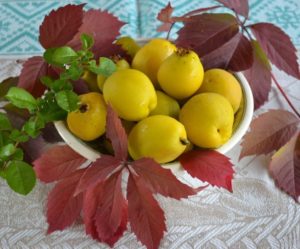
This fruit boasts amazing antioxidant properties thanks to its polyphenolic compounds. Antioxidants fight free radicals in the body, slowing the aging process and preventing heart disease and strokes.
Can Japanese quince be pregnant and lactating
On the one hand, Japanese quince is rich in folic acid, a compound essential for a healthy pregnancy. In addition, quince lowers cholesterol and protects blood vessels, which is certainly beneficial. On the other hand, the fruit has a diuretic effect, so it's best not to overuse it. Ideally, you should limit yourself to three servings per week.
Is Japanese quince good for children?
The benefits of Japanese quince and its use in the children's diet are explained as follows. The riterpenes and sterols contained in it suppress the reaction that causes sore throat and the more dangerous subsequent rheumatic fever. In addition, the fruit has a proven anti-inflammatory effect, which reduces swelling and soreness associated with sore throat and airway swelling in colds and flu. Quince has been found to help fight sore throats caused by bacteria. The tannins in the fruit inhibit hyaluronidase, an enzyme produced by bacteria that causes painful swelling in the throat and nasal passages.
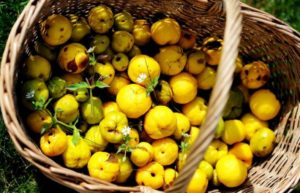
What diseases does Japanese quince help with?
In traditional Chinese and Japanese medicine, quince is considered a tonic - a medicine that stimulates strength and energy to heal. It is believed to increase the body's own ability to heal itself. The healing properties of Japanese quince are multifaceted, including cancer prevention, weight loss, skin care, and more. In general, the benefits of Japanese quince are as follows.
- Prevents cancer... Oncology is one of the most discussed issues these days. Not surprisingly, anything that can reduce the likelihood of developing this condition immediately becomes quite popular. The high content of antioxidants, including phytonutrient and phenolic compounds, is very effective in eliminating and neutralizing free radicals in the body. These elements are byproducts and dangerous products of cellular metabolism that can lead healthy cells to mutation or death, causing harm to the body. The antioxidant substances found in the product are directly linked to a reduced risk of most types of cancer.
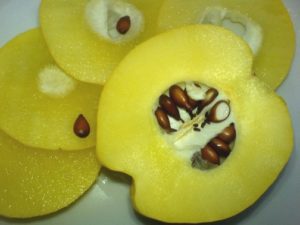
- Treats gastrointestinal diseases... In addition to improving the functioning of the digestive tract, which comes from fiber, the fruit can also help prevent a number of gastrointestinal diseases, including inflammatory bowel conditions or diverticulitis. The epicatechin and catechin found in the fibers react with some carcinogenic toxins that accumulate in the colon. It helps protect the mucous membranes of the digestive tract.
- Regulates blood pressure... Potassium is one of the most important minerals in the human body because it is needed to maintain blood pressure and transport fluid efficiently through cells. Since it is found in sufficient quantity in chinomeles, it will help normalize blood pressure.
- Allergic reactions... Japanese quince has long been renowned for its ability to keep allergic reactions under control. When applied as a gel or balm to the skin, it is beneficial in relieving symptoms of atopic dermatitis and other similar skin conditions. High amounts of vitamin C can help control inflammation and improve the appearance and health of your skin.
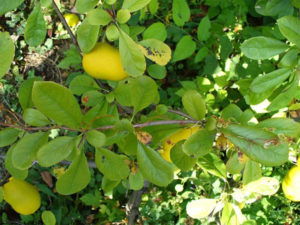
- Boosts immunity... As noted above, quince is rich in antioxidants. They, together with vitamins (in particular C and E), stimulate the immune system in various ways. For example, vitamin C helps to increase the supply of white blood cells, which are the body's main line of defense against viruses, pathogens and bacteria.
Traditional medicine recipes
The use of Japanese quince with health benefits has been practiced for a long time. Its beneficial properties are used to prepare decoctions and tinctures that help against many diseases. It can improve metabolism, reduce inflammation and raise immunity, help cope with gastrointestinal problems, and so on.
Quince tincture
The healing properties of Japanese quince are most concentrated in vodka liqueur. To prepare it, take only ripe fruits. They are washed and completely cleared of seeds, after which the pulp is cut into small pieces. Everything is put in a jar and poured with vodka so that the chaenomeles is completely covered. The container is closed with a lid and transferred to a dark place for three weeks. After this time, sugar is added to the mixture and left to infuse for another week. The ready-made healthy tincture of Japanese quince should be filtered and poured into small closable vessels. It is better to store it away from light sources. Half a kilogram of quince pulp will require 150 grams of granulated sugar and 800 ml of vodka.
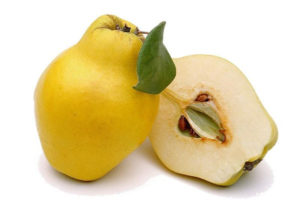
Quince seed broth
The benefits of Japanese quince seeds are controversial.On the one hand, they contain a lot of useful substances, on the other hand, they contain a certain amount of cyanide that can cause harm. Therefore, they should be brewed whole so that a minimum amount of a dangerous compound gets into the broth.
The beneficial properties of such a decoction are most pronounced in the treatment of cough and inflammation in the throat. It is also effective as an external remedy for burns and skin diseases.
To prepare a decoction with healing properties, you will need 10 grams of seeds. They are poured with a glass of boiling water and boiled in a water bath for about 15 minutes. The finished product is filtered and used three times a day.
Infusion on quince seeds
The benefits of Japanese quince seeds are also used in the treatment of hoarseness in the throat and trachea, as well as for other ailments. Their oil prevents perspiration, strengthens the heart, liver and stomach. To avoid harm from the cyanide contained, the infusion is made with water. To prepare it, 10 grams of seeds should be poured with water (in the amount of a liter) and left to infuse for about 12 hours.
The use of Japanese quince in cosmetology
In cosmetology, the beneficial properties of the seeds and leaves of Japanese quince are widely used. In this case, external use, they can not cause harm. The extract from the leaves of the plant has a softening, moisturizing and anti-inflammatory effect. A decoction of these can be helpful in treating brittle hair, dandruff and seborrhea.
Plant extracts also help with increased oily hair and skin. The beneficial properties of decoction of seeds are widely used to eliminate eye fatigue. It is also used to wipe problem skin.
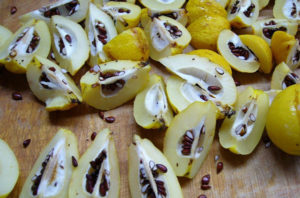
What can be cooked from Japanese quince
Many would agree that this Japanese quince tastes too tart and unpleasant when raw. However, if consumed frequently, the taste buds will adapt over time and the fruit will taste delicious. Some experts argue that the texture of chaenomeles takes some getting used to. It resembles a cross between an unripe pear and a hard apple.
Since fruits contain a lot of pectin, they are most often used in the form of jelly, jam, marmalade, juice or compote. It is also possible to bake Japanese quince in the oven. It is also great for filling pies, pies and muffins.
Compote
The benefits of Japanese quince compote are undeniable: it contains many vitamins and is able to strengthen the immune system. It is especially good in the season when you can enjoy a freshly prepared drink. Preservation somewhat reduces its beneficial properties. To cook compote, you need the following:
- 500 ml of water;
- 200 grams of granulated sugar;
- half a vanilla pod, cut in half;
- 1 cinnamon stick;
- 1 kg of quince;
- juice of half a lemon.
In a saucepan, mix water, vanilla pod, sugar, cinnamon stick and bring everything to a strong boil, stirring until the sugar is completely dissolved. At this stage, it is required to boil the mixture for one minute and turn off the heat.
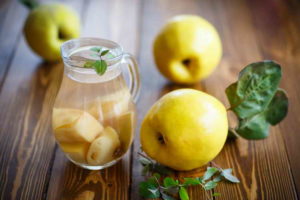
Prepare a bowl of cold water and lemon juice right away. Japanese quince needs to be peeled with a sharp knife, cut in half and cores removed. After that, each fruit is cut into four or eight pieces, depending on the size. All these pieces must be placed first in water with lemon for a few minutes, and then back into hot syrup. Turn the heat back on, bring the mixture to a boil, and simmer over low heat for about 50 minutes, until the pieces are soft and pink. When the compote is ready, remove the cinnamon stick and vanilla pod.It is advisable to chill the drink before serving.
Juice (recipe + benefits)
The health benefits of Japanese quince have not yet been studied at the medical level, but the juice from it is traditionally used to relieve digestive disorders, including stomach and intestinal pain, as well as diarrhea. It also helps with coughing. Since quince contains several phenolic compounds and essential oils, its fruits have a unique aroma. Ripe Japanese quince juice is an excellent source of vitamins B and C, as well as minerals such as copper, potassium, iron and magnesium, which provide undeniable benefits. Due to its too tart taste, it is recommended to make it with the addition of other fruits. For one of these healthy drinks you will need:
- 1 quince;
- 1 slice of fresh lemon;
- 1 orange;
- 1 apple;
- 1 cup fresh pumpkin pulp, diced
- a pinch of cinnamon.
First you need to clean all the components of Japanese quince from the peel, seeds and cores, the useful properties of which are minimal. After that, everything is crushed in a blender to a thick smoothie, which should be diluted with water to taste.
Jam (recipe + benefits)
The benefits of Japanese quince jam are as follows. Since the fruits contain a lot of pectin, they do not need to be cooked for a long time. This means that the beneficial properties of the product are not lost during processing. All vitamins and minerals are retained in the finished jam. To cook it, you need the following:
- 1 kg of quince;
- 2 lemons;
- 1.5 kg of sugar sand.
First of all, you need to wash the quince fruits. You don't need to peel them, just cut them into quarters and remove the core. The prepared pieces are placed in a large bowl and poured over with the juice of one lemon. All this should be filled with water to avoid darkening of the quince.

Next, the pieces of Japanese quince should be placed in a medium saucepan with one liter of water, brought to a boil over high heat. After that, the fire needs to be reduced, and the jam must be cooked on minimum heat for 1 hour.
Then most of the water must be drained, and the quince fruits must be cut into 1 cm pieces and placed back in a saucepan with sugar and the juice of the remaining lemon. Stir the contents of the pan until the sugar dissolves, then bring to a boil over low heat. Cook for 45 - 60 minutes - until the quince turns pink. You need to store this healthy jam in sterilized jars.
Harm of Japanese quince and contraindications
Are the benefits and harms of Japanese quince for human health unequivocal? In fact, there is no clear evidence of side effects or potential harm associated with consuming chaenomeles. All the available data indicate that these fruits are an excellent component of any diet.
However, quince seeds contain a small amount of cyanide, and for this reason, you should not eat more than a few pieces. Otherwise, it can cause harm, provoking poisoning. Additional research is currently underway to study the benefits and harms of chaenomeles.
Probable harm from its use can also be caused by allergic reactions, since it contains a lot of active substances. Another contraindication is the presence of acute inflammation in the large and small intestines.
How to choose and store Japanese quince
These fruits ripen in the fall, and many people unknowingly bypass them on the counter. Unfortunately, quince is not a well-known product of the fall season. Most consumers don't know how to choose the right one.
Japanese quince in unripe form often looks like a large light green plum.When it is ripe and ready to eat, it achieves a bright yellow hue with small splashes of brown. In addition to its pleasant appearance, its sharp fruity aroma attracts attention from afar.

To use the beneficial properties of chaenomeles to the maximum, the brightest and most fragrant fruits should be chosen. They must not have any external damage or discoloration.
It is best to store Japanese quince in the refrigerator or in a cool dark place.
Conclusion
If you remember what the benefits and harms of Japanese quince are, you can safely use it in cooking and traditional medicine. As can be seen from the above, there are very few contraindications to its consumption, and only seeds can cause harm. Quince can be used to make delicious desserts and drinks containing a significant amount of vitamins.

